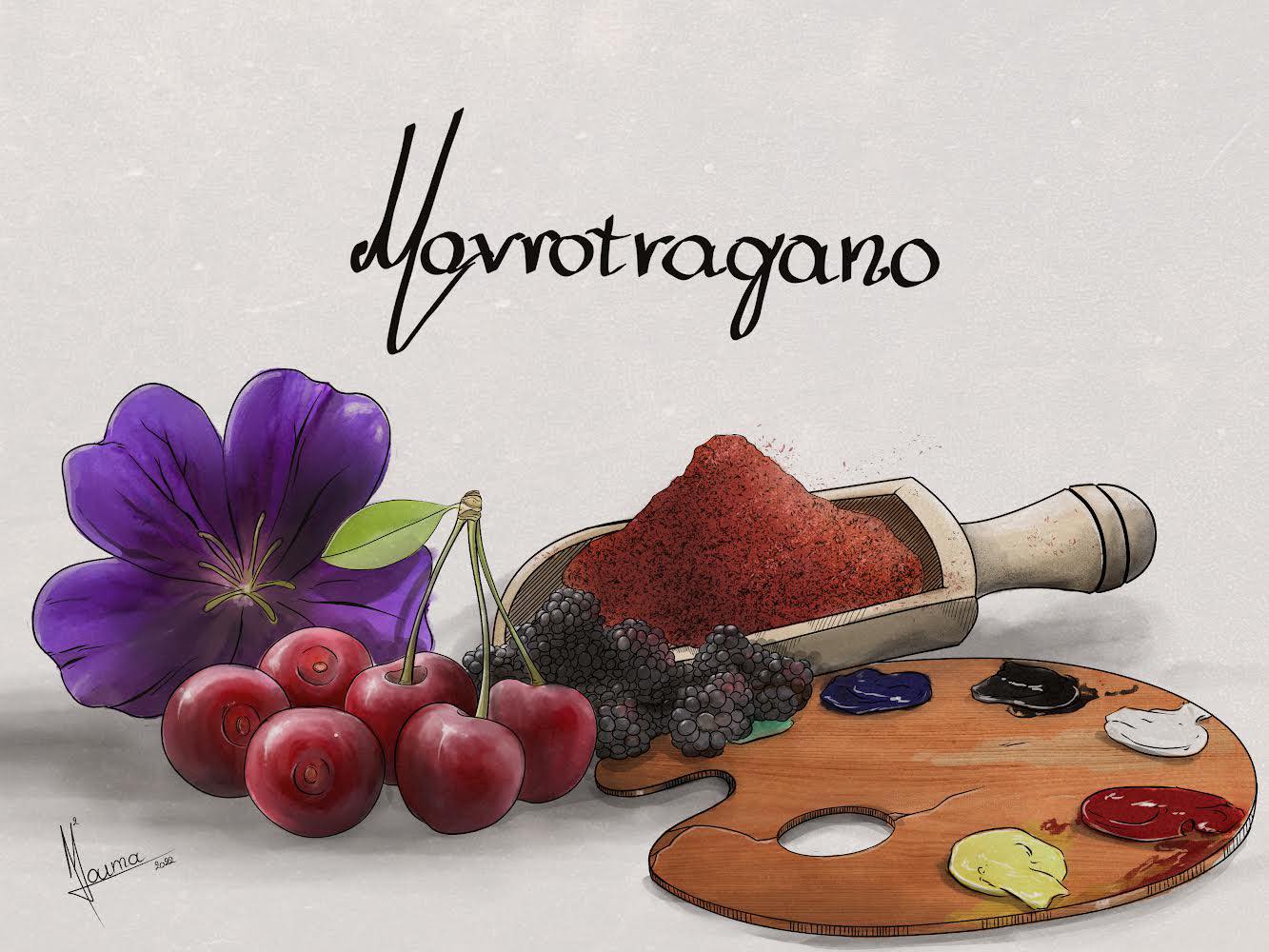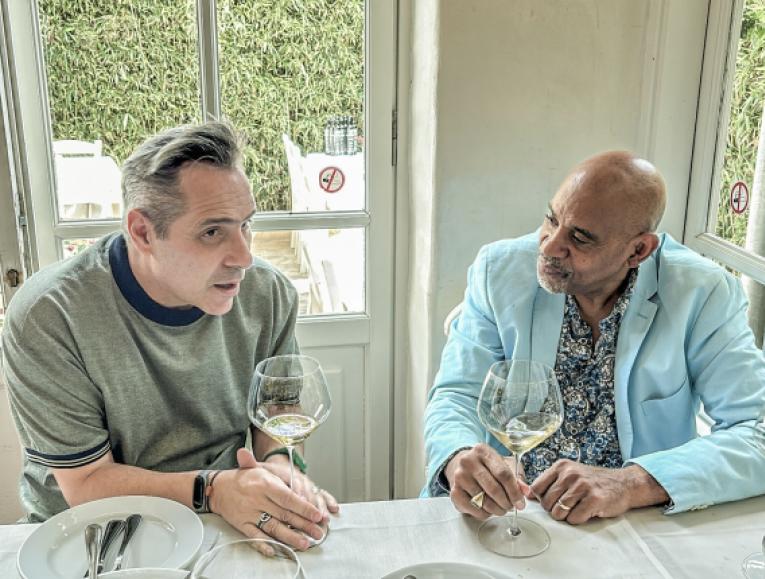
Mavrotragano
By Yiannis Karakasis MW and Evmorfia Kostaki
In a nutshell
Mavrotragano (Ma-vro-TRA-ga-no) is an indigenous Greek red grape variety, grown initially on the island of Santorini but is now increasingly widespread across Greece. The name stands for "black and crunchy" and accurately describes the texture of the fresh grapes. For many years Mavrotragano was battling extinction. But following the commercial success of its wines, which also enjoy high prices, the Clos Stegasta from T-Oinos winery, in particular, is becoming popular among grape growers and wine producers.
Current numbers show that it is planted in a few hectares, mainly on the islands of Santorini and Tinos. Beyond these, there are scattered patches in Northern Greece. It is a deeply coloured, tannic, and medium-to high-acid red grape variety that displays aromas and flavours of wild berries, red cherries, spices and minerals. It is fruity, supple, full-bodied and powerful with savoury characteristics reminiscent of northern Rhône Syrah. Highly concentrated examples can age in the bottle for over a decade (Karakasis, The Wines of Santorini).
History
Mavrotragano vines are found traditionally on the island of Santorini. It was also grown in other islands or the mainland but was extinct during the phylloxera attack. After that, grape growers would not want to replant a grape whose yields are inconsistent such as Mavrotragano. On Santorini, it covers an estimated 14 hectares, or a bit more than 1% of the total vineyard area, even though plantings are on the rise. On Tinos island, the total plantings are estimated at 5 ha.
The first reference of the variety came in the 19th century. It was mentioned as one of the grapes used for sweet Vinsanto wines (Kourakou, Santorini An Historical Wineland). According to producer Paris Sigalas, Mavrotragano was co-fermented with other varieties in Vinsanto blends due to its highly aromatic profile and high maturity levels. The new era of the grape came when Santorini producers Sigalas and Hatzidakis released in the late 90s single varietal expressions of the wine. These sparked the curiosity of the trade and other grape producers, and today single varietal wines are made from at least 10 Greek wineries, and even more, use the variety in a blend.
Viticultural Characteristics
Mavrotragano is one of the many rediscovered Greek varieties that are now re-emerging. Unfortunately, producers have limited scientific resources regarding the attributes of the grape and the correct viticultural practices. There are, therefore, no registered clones for the variety. However, heterogeneity is observed within the variety, and the Hellenifera project has nine clones under investigation. The high varietal heterogeneity compared to other Greek varieties can also be observed in this PCA plot from the Kyraleou group research paper (https://doi.org/10.1016/j.jfca.2020.103547) which groups different varieties by their anthocyanin contents.
Mavrotragano is a mid to late-ripening variety, with harvest in late August to mid-September, depending on the region and the wine style. This creates a long growing season, since bud break is already at the end of March to the beginning of April, flowering in mid-May and véraison in late July (Stavrakas, Ampelography 2010). Its cycle can be considered similar to Cabernet Sauvignon.
One of the biggest struggles with the grape is its buds' low fertility and very inconsistent yields. Producer Thanos Dougos comments on getting tiny yields of 21 to 56 hl/ha. This could be (its low yields) why it had not been widely planted.
Despite its low yields, it is a vigorous variety, a trait often exaggerated with its combination with vigorous rootstocks, like 110 Richter. However, drought-resistant rootstocks are necessary since Mavrotragano is not highly tolerant of drought.
While on Santorini, it can be trained using the Kouloura method, the most common training system is Double Guyot on wire training. This is because the low fertility of the basal buds makes cane pruning more suited for the variety, and using two canes (Double Guyot) instead of one (as would be in a single Guyot) promotes homogenous ripeness.
Training on wires also allows more sunlight to reach the bunches, therefore softening the grape's abundant and otherwise rough, grainy, Nebbiolo-like tannins. According to recent research (https://doi.org/10.1016/j.jfca.2020.103547), Mavrotragano has the highest petunidin and delphinidin in skin total anthocyanins, compared to other popular grapes (Xinomavro, Agiorgitiko, Kotsifali, Mandilaria). It also has the highest percentage of epi-gallo-catechins in its total skin proanthocyanins, which explains the harshness of its tannins. However, this phenolic composition can be a disadvantage if careless viticulture is applied. Many Santorini producers have followed Sigalas's example by wire-training their Mavrotragano vines (Karakasis, The Wines of Santorini). Even so, some wines display dry, grainy tannins that lack elegance and can be aggressive, leaving a rustic impression on the palate. In addition, Mavrotragano takes time to achieve full phenolic maturity. By this point, alcohol has often risen above 16%, affecting overall balance. Another challenge is that fully ripe bunches often include small, underripe green berries (millerandage) that can have a negative impact on the quality of the wine.
When trained on wires, Mavrotragano grapes reach better tannin ripeness due to better exposure to the sun. The resulting wines appear to be more balanced in alcohol and tannins.
Oenological Characteristics
The recent interest in the variety, expressed through its single varietal wines, means there is not much practical experience or scientific knowledge regarding its winemaking. However, here are a few things we know about the particularities of the grape in the winery.
Mavrotragano's most significant implication is the harvest date. As discussed above, the variety is prone to millerandage resulting in a mix of overripe berries with underripe ones. There are two main trends regarding harvest dates. Producers either harvest early, keep the fine acidity, follow with gentle winemaking to avoid tannins, or let the grapes reach a more homogenous state, creating wines with higher alcohol, which can also be more extracted since the tannins have softened on the vine. Alcohol, therefore, ranges from 13 to 14.5% abv.
What's more, there are often small green berries within the bunches that never ripen. Destemming is usually required to remove them; otherwise, they result in pyrazines (vegetal) notes and contribute to harsh tannins. However, T-Oinos winery practices partial whole bunch maceration of Mavrotragano with excellent results.
The variety's high tannin and anthocyanin content increase its need for oxygen. Therefore, gentle aeration during fermentation is practised daily, and vessels that enable macro-oxygenation, like oak barrels, are frequently used.
The age of oak barrels depends on the producer, but Dougos reported that 1/3 of new oak in the blend gives the best results. 100% new oak may do more in softening the tannin profile but greatly overpowers the fruity aromas of the grape. Ageing time in wood is again dependent on the producer, with maturation from less than a year to a full two years.
Rosé winemaking is also becoming increasingly popular. Mavrotragano is mainly grown in the Greek islands, where most consumption occurs in the summer months. The need for the wineries to offer a rosé wine is high, and Mavrotragano is one of the few red varieties, along with Mandilaria, grown in the Cyclades. The use of Mavrotragano for the production of rosé wines is perhaps not because of its inherent ability to produce this style. Its colour is dark, the tannins can be harsh, and acidity is medium. For that reason, it is blended with other grapes, like Avgoustiatis, Mandilaria, and even the white Malagousia.
Terroirs
Santorini
Mavrotragano covers a bit more than 1% of the Santorini vineyard, with an estimate of 14 hectares. Santorini's climate is dry and hot, with constant winds and increasing water stress. Growing Degree Days on the island are 2585 (https://doi.org/10.1002/joc.5320), and the average annual rainfall is a bit more than 300 mm but can be as low as 100 mm. These conditions can cause any variety to struggle. Mavrotragano copes by giving low yields and can easily reach 16% abv, while tannins can still be rough. Careful handling in the vineyard and the winery is necessary, and training in double Guyot instead of the traditional Kouloura has signified a significant improvement in tannin development.
The single varietal wines are made in two styles; either light and fresh, with an attractive red fruit profile, or full-bodied, with higher alcohol content and generous extraction, able to age for many years. It is still used in blends, mainly with Mandilaria, in Vinsanto wines, albeit in tiny percentages. ''It is one of my two favourite Greek red varieties, and a personal bet for the winery'' says producer George Gavalas adding that '' there different interpretations of the variety something encouraging. A (commercial) drawback is its price. Mavrotragano wines are always expensive because they are rare.''
Tinos
Mavrotragano seems to have found a favourable terroir in the Tinos island, where higher altitudes compared to Santorini (usually 400 m) permits an extended growing season and improved tannin ripeness. Most vines are found on granite bedrock with sandy clay soil yielding approximately 20 hl/ha. ''Mavrotragano is a fascinating variety with great potential,'' comments Thanos Georgilas, winemaker at T-Oinos winery. He adds that it suits Tinos's climate because the altitude means prolonged phenolic maturity without sacrificing acidity or freshness.
Rest of Greece
Outside of the Cyclades islands, Mavrotragano is now found also in mainland Greece, mainly in the northern part, on the slopes of Olympus and Khalkidhiki. Mavrotragano seems to enjoy the cooler temperatures and higher rainfall of these areas. The critical period from véraison to harvest is slower here, so it's easier for the wines to be well-balanced. Here too, plantings are increasing, and producers are focusing on discovering the best-suited mesoclimates for the grape. Wine quality is already high but is set to grow even more in the coming years.
Trends
Considering all of the above, one could say there is still not a clear direction for the wines of Mavrotragano. This is only logical, as the variety has started being in the spotlight for only about 20 years or even less. And in wine, 20 years is a very short time, as one vintage is possible per year, meaning a limited chance to experiment.
New terroirs are examined every year in the vineyard through new plantations, and harvest dates are becoming more and more precise, corresponding to the desired wine styles. In the winery, winemaking is adapting to the variety instead of the other way around.
Through tactical observation and communication between the producers and increasing interest in the variety from the Greek scientific community, we can expect even greater things from Mavrotragano in the coming years!
Ageing potential
More than 10 years for best examples. Boundaries are still explored. Top examples need a minimum of 4 years in the bottle and decanting to express their complexity.
Notable producers
Santorini: Sigalas, Hatzidakis, Karamolegos, Santo. Gavalas, Argyros
Tinos: T-Oinos
Mainland Greece: Moschopolis (blend with Syrah), Michailidi, Gerovassiliou (blend with Limnio and Mavroudi), Dougos



